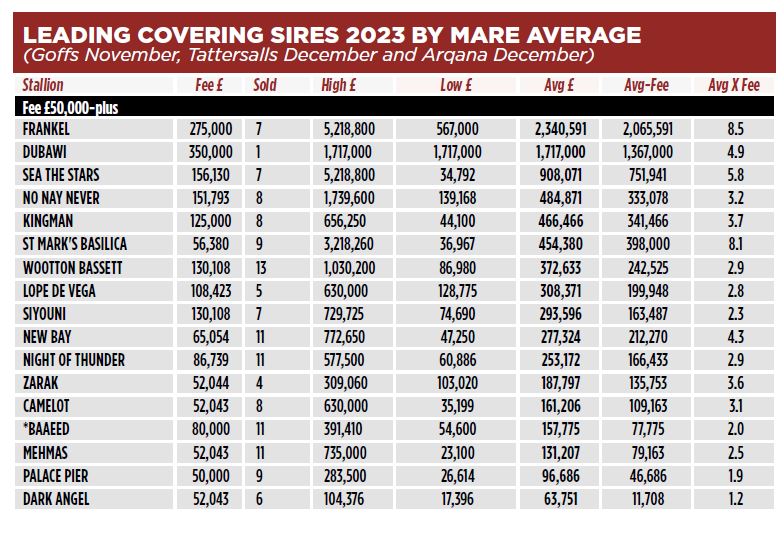The 2023 breeding stock sales at Goffs, Tattersalls and Arqana provided many spectacular moments, most coming during the Niarchos reduction at Goffs. And it was this draft more than any other factor that embellished the sales return for in-foal mares last year. Goffs saw its average price for pregnant mares jump from £51,000 in 2022 to £128,000 for 2023. Tattersalls and Arqana, meanwhile, produced averages broadly in line with 2022 figures. Tattersalls went from £102,000 in 2022 to £101,000 last year, while Arqana posted a modest increase from £49,000 to £52,000.
The Niarchos draft contributed five of the ten in-foal millionairesses sold at public auction in 2023, sisters Alpine Star (in-foal to Frankel) and Alpha Centauri (Sea The Stars) equalling the previous best price of €3 million set by Chicquita ten years earlier, despite the best efforts of auctioneer Henry Beeby to set a new landmark broodmare price for Goffs. But as is ever the case at bloodstock auctions, a few shining examples of outstanding quality can and frequently do hide us from the real world, as the disparity between the average (€124,623) and median (€18,000) at Goffs outlines all too clearly. Taken as a group, the three main outlets for in-foal broodmares had their share of tricky moments.
It’s easy to understand why so many mares are over-covered these days as stallion studs try to make good in their investment by going after as much revenue as possible. But there are inevitable financial consequences for the mare owner that play out thereafter. The first opportunity to witness what happens when you over cover your mare usually takes place at the mare sales. This year as many as 37% of all in-foal mares sold at the main three auctions failed to make enough to cover the advertised fee of their covering sire. The corresponding figure for 2022 was 33% and 34% the year before that. It’s a recurring theme that just goes to show hope springs eternal in the minds of many sellers.
Despite a rise in loss-making transactions, the big three auctions as a group posted an average price of £92,081, well clear of last year’s £69,835 and 2021’s £56,295, all of which is great news for those operating at the elite end of the market. The 2023 average price was produced off an average covering fee of £27,967 or about 30% of the average selling price, and perhaps that is the relationship between mare value and covering fee that represents the sweet spot – there was a potential profit for all those who achieved that broodmare value-stallion fee relationship. But there were fewer that did so in 2023, with 22% making at least three times fee compared to 27% in 2022 and 24% in 2021.
Market segmentation perfectly illustrates the polarity that exists
The average price for an in-foal mare at Goffs, Tattersalls and Arqana may have been up 32% compared with last year, but market segmentation perfectly illustrates the polarity that exists. The top quartile averaged £316,000, up from £226,000 last year, but the second quartile average came in at just £38,000, up from £37,000 last year and £34,000 the year before that. Of course, all of these broodmare market trends need to be understood against a backdrop of how a major reduction can distort the financial landscape in any given year. In that sense, mare sales will never as useful an industry barometer as the yearlings are.
Among the first-season stallions of 2023, Baaeed was the only representative in the £50,000-plus group and although his mares produced a healthy average, it was by no mean plain sailing for the top-class son of Sea The Stars. Three of his 11 mares did not make back the £80,000 investment in a nomination to Baaeed and only two brought an ideal three-times fee or better. Coolmore’s No Nay Never stallion Blackbeard had 23 mares offered at the three big sales and they produced an average price of £71,791, which generated a better price-fee ratio (3.3) than Baaeed’s 2.0, albeit from a lower fee of €25,000. Ten of his mares sold very well making the desired three-times fee, but seven also sold for less than his advertised fee.
State Of Rest was the most popular first-season covering sire
Rathbarry Stud’s State Of Rest was the most popular first-season covering sire standing at between £20,000 and £50,000. He produced an average of £43,642 for nine sold. Among the £10,000 to £20,000 cohort, Ballylinch Stud’s Bayside Boy (£37,318) and Darley’s Naval Crown (£36,004) both of whom had five mares sell, did best of all. Derrinstown Stud’s Minzaal (£31,135 for five sold) wasn’t far behind. Also in this category were Arc winner Torquator Tasso, whose three mares generated an average of £25,469 off an opening fee of €20,000, and Darley’s young Ardad stallion Perfect Power, whose five mares averaged £21,819.
In the sub-£10,000 category, Thunder Moon and Caturra were the most popular. Just to underline the point than not even a first-season stallion can make up for over-covering a mare, we can point to the fact that of the 94 mares sold at Tattersalls, Goffs and Arqana in 2023 in-foal to new stallions, only 59 covered their conception fee.
Among the £50,000-plus stallions who are not in their first year, it was Frankel, with seven mares sold, who justifiably proved top of the table. He had five millionairesses, Alpine Star, Teona, That Which Is Not, Geocentric and Primo Bacio plus two more that made more than 500,000 guineas at Tattersalls.
Sea The Stars posted the next best average, but his figure was inflated by the Alpha Centauri’s €6 million price tag. Of the other six, only Ambivalent justified her high-end mating with the Gilltown Stud stallion, making €925,000 at Goffs. All the others failed to cover Sea The Star’s €180,000 fee, including The Fugue’s half-sister Selyl, who was sold for just €48,000, and Ninaz Terz, a €40,000 purchase for whom none of the first five foals have yet made the breakthrough at black-type level. Needless to say, both could turn out to be very shrewd investments.
Only four sires represented by five or more in-foal mares delivered 100% records when it came to surpassing conception fees and they were the aforementioned Frankel, Whitsbury Manor Stud’s Havana Grey, plus the Ballylinch pair of Bayside Boy and Lope De Vega.
If we limited the study to ten or more mares, the winners would have been Too Darn Hot (95%), Wootton Bassett (92%) and Blue Point (89%), with a special mention to Sioux Nation, who had 21 of his 25 surpass his fee. The leaders by a fee multiple of 8.5 were the Galileo pair Frankel and Intello, who benefitted enormously from the €400,000 sale of Plumage, a Dubawi mare from the Wertheimer brothers’ famous Featherhill family and thus closely related to Dubawi’s Group 1 winner Left Hand. St Mark’s Basilica was another (8.1 times fee) that did well by this metric.







